Children are interested in images of domestic animals depicted in illustrations and photographs. Young artists strive to capture in their drawings what surrounds them. The sheep is a touching hero of cartoons and children's magazines. It will be interesting for a child to try to create such a funny and slightly naive character himself.
General rules for drawing a sheep
The sheep (a drawing for children is easy to do) differs from other domestic animals primarily by its large shock of curly wool. It is depicted with small semicircular curls.
To accurately convey the unusualness of the fluffy wool, a very young artist is asked to compare the outline of the sheep's body with a cloud. This will make it easier for the child to convey the image of the animal on paper.
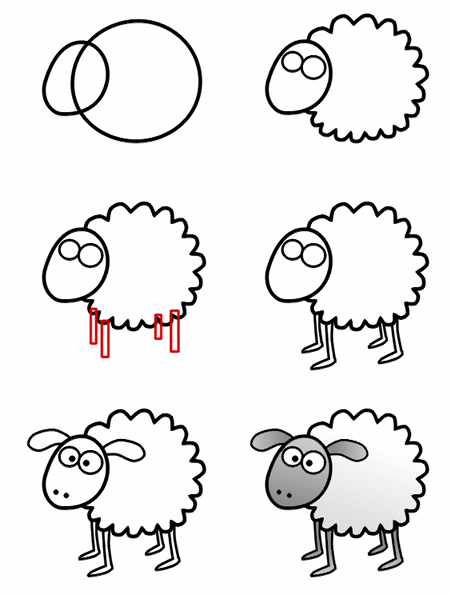
The most advantageous angle is to draw the sheep in profile, with its head turned towards the viewer:
- The oval shape of the head with a small "cap" of fur on top is outlined with soft lines. Talking with the young author about the character of the depicted hero, they pay attention to the kindness and harmlessness of the character.
- On the muzzle, draw two eyes and a small semicircular nose.
- The ears are drawn in the form of elongated ovals, directed in different directions.
- You can tell the child that a sheep usually doesn't have horns, but a ram grows horns.
- Further, at the bottom of the body, 4 legs are depicted, emphasizing the unusualness of the elements - on each leg the sheep has only 2 toes, which end in hooves.
- The bottom of the hooves is outlined with angular, clear lines.
- The last detail is a small rounded tail, which is drawn with rounded strokes.
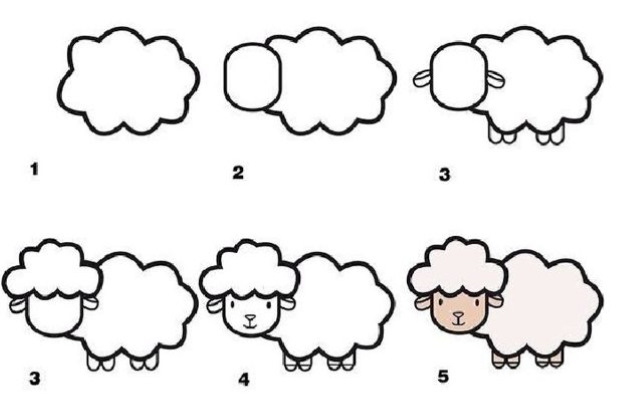
The resulting picture can be colored:
- pencils;
- felt-tip pens;
- markers
- wax crayons;
- paints.
If you plan to create a graphic image, use contours of different thickness. Thicken the outline of large parts, as well as the lower line of the hooves - this technique will create the impression of stability of the character in the drawing.
A thin outline is used for head details, muzzle outlines, and curls of fur. The young author can be offered to supplement the work with a simple landscape: trees, meadow plants.
An interesting option for completing the composition would be to use stamps and stencils to color the animal's fur and the flowers around it.
Simple pencil drawing
The sheep (the drawing for children is not a naturalistic image) can be drawn with ordinary pencils.
Conveying an accurate, almost "photographic" image of a pet is sometimes an impossible task for a child. Therefore, stylizing a character will add an element of play to drawing and make the activity easier.
What tools will you need?
Pencil drawings can be done using regular album sheets. Drawing paper is well suited - the density of the texture of such material will ensure a soft display of lines, preservation of the color layer.
Office paper for printing and copying is somewhat thinner and less comfortable to draw on.
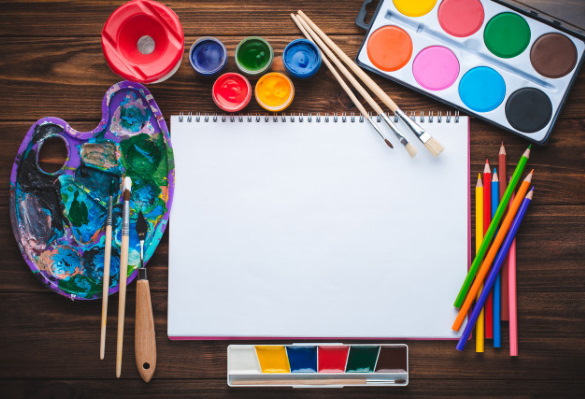
The following materials are prepared:
- A4 sheet;
- simple hard-soft pencil;
- eraser;
- ruler;
- For coloring, use light brown, pink, gray, blue pencils or wax crayons.
How to draw
The work is carried out following the steps listed in detail.
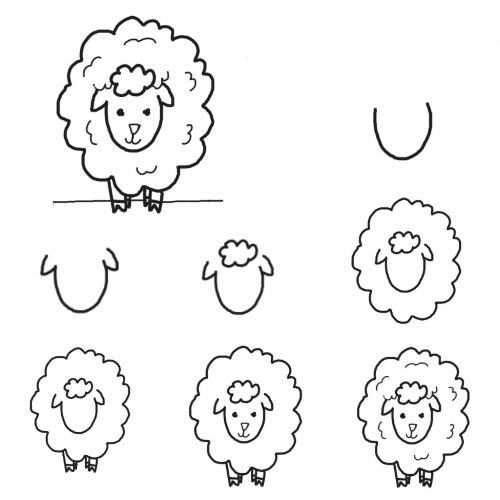
| Stage | Description |
| 1 | Mark the boundaries of the future composition, leaving 2-4 cm margins along the edges. This will make the work look more attractive. |
| 2 | In the center, a large oval is thinly outlined. This is the body of the sheep. The child can be asked to use a stencil figure ruler. Then, rounded lines are applied along the edges of the oval, making a "cloud" of wool. The lines should be uneven, reflecting fluffy curls. |
| 3 | On the left, draw another oval with a thin line - the head. In terms of mass, it takes up about a third of the animal's body volume and intersects the oval of the body with half. The head should not be made too big or too small. |
| 4 | Next, at the bottom of the head, its outline is slightly bent to the left side, drawing the character's muzzle. The middle of the head is marked vertically and horizontally, two large dots are depicted in the upper left part - these are the eyes. The young artist should be helped in marking the oval of the head, this stage may be difficult. If desired, use a ruler. |
| 5 | Dividing the lower half of the muzzle in half again, draw the nose at the bottom left in a semicircle. Connect the lower point of the nose with a short straight line to the lower edge of the head outline. Then draw the mouth to the right of the nose with a smooth rounded line, making a smile. |
| 6 | A little above the eyes, outline a "cloud" of wool on the sheep's head, making it not too large. It is important to draw the child's attention to the fact that the highest point of the head is significantly lower than the highest point of the back. On the sides of the head, draw elongated pear-shaped ears. The median transverse line dividing the head in half is a guide for the placement of the ears. |
| 7 | Move on to outlining the sheep's front legs. A vertical line drawn from the point where the right ear connects to the head is the border of the left leg. A little further back from the extreme point of the ear, a vertical line is also drawn. The result is a line that marks the edge of the right leg. Next, the area of the front legs is divided in half. |
| 8 | The hind legs are drawn under the right side of the oval of the body. All legs are approximately equal in weight. Hooves, divided in half, are drawn at the bottom of all 4 legs. The lower points of the hooves should be located at the same level. |
| 9 | A small tail is drawn on the back of the sheep using soft lines. |
How to complete a drawing
You can leave the graphic image of the sheep, drawing only the outlines of the figure with markers of different thicknesses. Most young authors will be happy to color the resulting character, for this the adult suggests choosing the necessary colors.
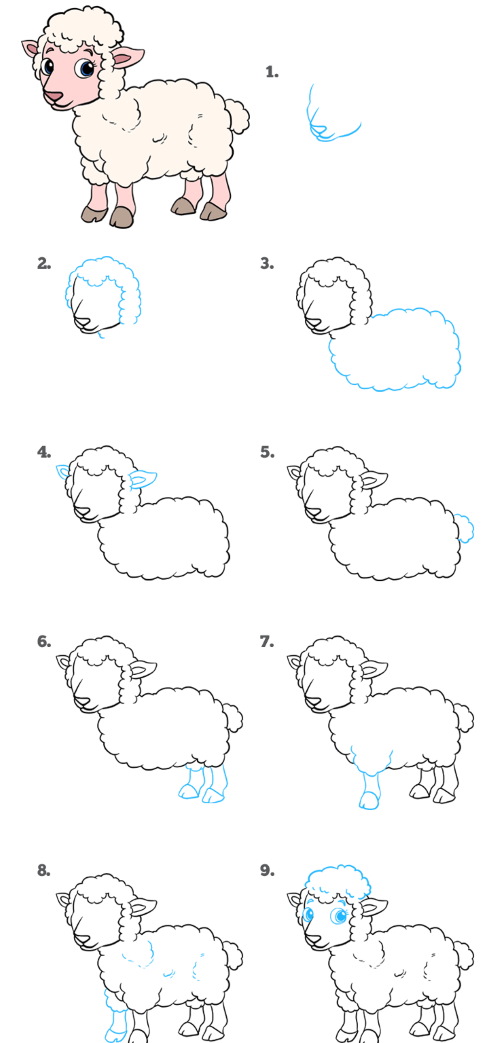
The upper part of the muzzle and legs are filled with brown shading. The hooves and ears are colored with gray pencil. The area of the head where the nose and mouth are located is colored with pink. A blue pencil is useful for adding volume to the body.
With paints
The sheep drawing, depicted in paints, will be interesting for children due to its unusual coloring technique. A stamp made from a tightly rolled up cloth napkin is used. The imprint is obtained in the form of a curl, similar to the texture of the animal's wool.
What tools will you need?
They choose gouache paints with good covering properties and bright shades. They plan to depict the sheep's wool with white paint, so the child is asked to choose a sheet of colored cardboard for work.
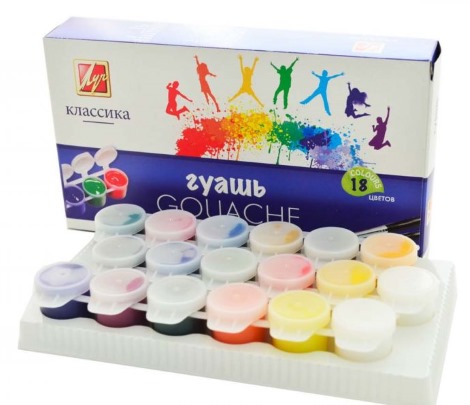
It is better to give preference to a light background (pink, orange, light green, blue colors), so that the brown and white details of the drawing will not be lost in the image.
So, the following items are prepared:
- A4 coloured cardboard;
- simple soft pencil;
- eraser;
- round thin brush;
- wide brush;
- gouache;
- viscose or cellulose napkin measuring approximately 21x21 cm;
- a cloth to remove excess paint;
- palette;
- container with water.
How to draw
The table lists the stages of work.

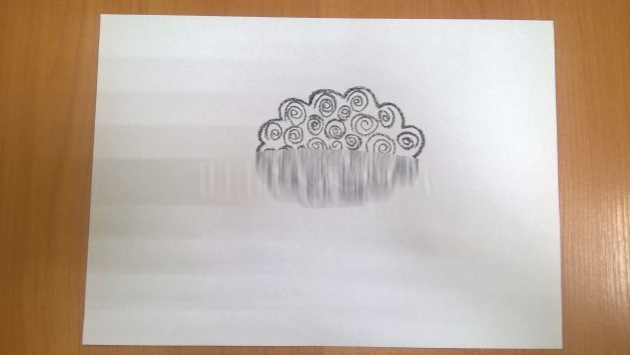
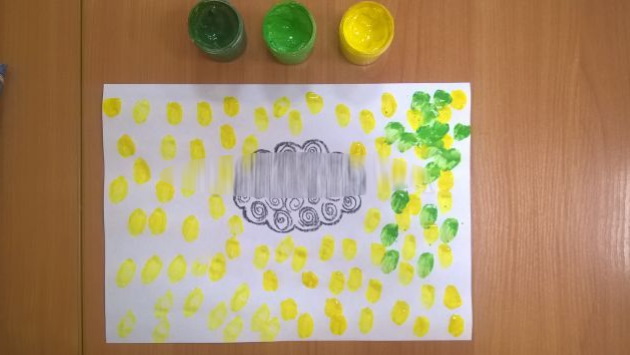
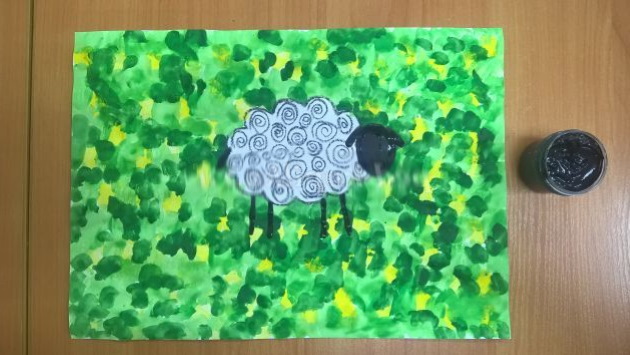
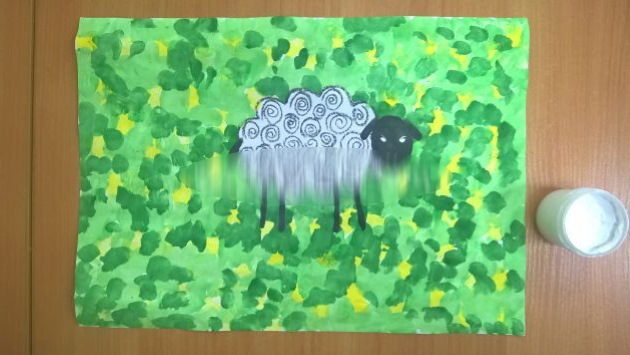
| Stage | Description |
| 1 | On a piece of cardboard, mark the place where the sheep will be drawn, standing sideways, with its head turned towards the viewer. The remaining elements of the composition are immediately planned. The child is asked to decide what to place next to the character:
|
| 2 | Draw 2 ovals with a pencil — the body and head of the animal. Draw the eyes, nose, mouth on the muzzle. Outline the contours of the ears, legs, tail. If necessary, outline the other parts of the composition. |
| 3 | Work with paints begins by identifying the lightest elements. In this case, it is the animal's fur. Using a wide brush, carefully paint the sheep's body and the "cap" of wool on its head with whitewash. Allow the gouaches to dry completely. If the cardboard shows through the paint, these details are painted 1-2 more times, drying the layers. |
| 4 | On the palette, mix white and a drop of blue gouache until a light blue color is obtained. Fold the dry napkin in four, then in half again. The resulting rectangle is rolled into a small tight roll, the lower part (where only the folds are) is dipped into the paint on the palette. Make round prints on the white parts of the body and head. Place the "curls" unevenly, trying to convey the texture of the animal's fur. |
| 5 | Next, add more blue to the blue shade to get dark blue. The new tone is used to imprint "curls", edging the lower contour of the body, tail, "cap" on the head. This will make the image more voluminous. By slightly darkening the shade of paint on the palette, you can add darker "curls", achieving greater volume. Gouaches are allowed to dry. |
| 6 | The head and legs are painted with a brush, using brown. After the paint dries, mix white and a drop of black - the resulting gray shade highlights the ears and hooves. By mixing brown with white, you can add 4-5 prints of "curls" along the lower edge of the body, giving the work a picturesque look. |
| 7 | The nose and mouth are drawn with pink paint (a mixture of white and a drop of red). A thin line is drawn on the ears with the same color, just below the upper border. The dots of the eyes are drawn with a thin brush, filled with black gouache. The paint layer is allowed to dry. |
| 8 | Additional elements of the composition are painted, then the work is completely dried. |
How to complete a drawing
The final stage is adding contours to the details. This is done with a thin brush and black gouache, a marker, or a felt-tip pen. After dipping a clean brush into whitewash, put small dots in the upper part of the sheep's eyes - this will make the character "live".
You can only outline the central elements of the composition (animals, house, fence). This technique will highlight the foreground on the sheet more clearly.
Sheep on the bridge
Sheep (a drawing for children can be diversified with an interesting plot) is a character to whom many children's poems and songs are dedicated. You can suggest that the child remember the poem by Sergei Mikhalkov about 2 stubborn lambs.
Based on the work, the young artist is asked to depict 1-2 sheep on a bridge, but not to emphasize the quarrel of the characters. As an option for the composition, a plot with a sheep standing on a bridge is chosen.
To make the work easier, draw the bridge by tracing any round object.
What tools will you need?
The following set of materials is prepared:
- a sheet of thick A4 paper;
- simple hard-soft pencil;
- eraser;
- round saucer with a diameter of 12-15 cm;
- coloring tools of the child's choice.
How to draw
The stages of drawing are described in detail in the table.

| Stage | Description |
| 1 | A clean, dry saucer is placed in the middle of the sheet with the upper half. A semicircle is traced along the contour with a pencil. The saucer is moved down by 1.5-2 cm and the 2nd semicircle is traced. The result is a bridge. The banks are drawn with symmetrical lines, and the upper water level in the river is outlined below the bridge. |
| 2 | Place the sheep on top of the bridge, outlining 2 ovals (head, body). The illustration shows an approximate composition. Then draw the details of the character:
If a plot with 2 sheep is chosen, the animals are placed on the bridge symmetrically, looking at each other, reduced in size relative to the figure shown in the figure. |
| 3 | They begin to color the elements of the image. The grass on the banks is shaded with green, and the water with blue. Brown and gray colors are chosen for the bridge. The same shades are suitable for the legs, ears, and muzzle of the sheep. The white fur of the body and head matches the background of the sheet, but the details can be "revived" by drawing spirals and curls in gray and blue colors. |
| 4 | For the image with 2 sheep, a contrast technique is used: the characters' bodies are made black and white. It is convenient to use gouache, using a stamp, as in the previous example. In this case, "curls" of white and gray colors are made on the black wool, making sure to let the initial layer dry well. You can not use a stamp, drawing the texture of the wool only with a brush. |
How to complete a drawing
The following actions give the work its completeness:
- outlining elements with a contour;
- adding white highlights to the sheep's black eyes;
- drawing trees, flowers, and the sun in the sky on the banks;
- the image of the outlines of logs on the bridge - they are drawn as circles.
In the clearing
Sheep (a drawing for children is done on simple topics) is an easy character to depict. The young artist can be offered to capture the animal in a meadow decorated with various flowers and butterflies.
In this composition, half of the sheet will be occupied by a grassy meadow, so a foam sponge is used for coloring. It is easy to color large areas on a sheet of paper. Watercolor and gouache paints are used in the work.
What tools will you need?
Together with the child, select materials for the lesson:
- A4 sheet of watercolor paper;
- simple hard pencil;
- watercolor, gouache;
- thin and wide brushes;
- rag;
- palette;
- container with water;
- foam sponge.
How to draw
The table is made up of a description of the successive stages of drawing.

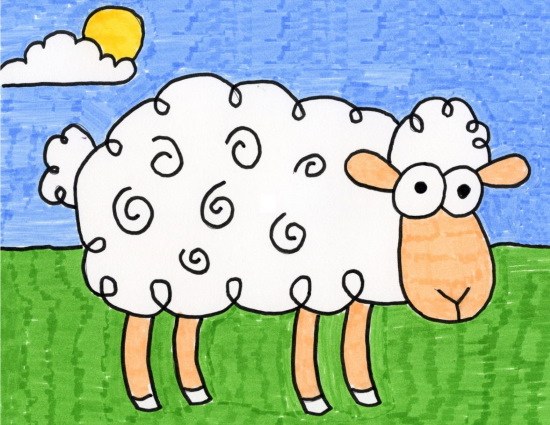
| Stage | Description |
| 1 | On the paper in the center they mark the location of the sheep, plants. The lower third of the sheet is a clearing, on the rest of the sheet they plan to draw the sun, clouds. |
| 2 | To draw a sheep, first outline 2 ovals for the body and head. Draw the curls of wool, muzzle, ears, tail, legs. Try not to use an eraser, so as not to damage the top layer of paper and not to spoil the subsequent work with paints. |
| 3 | After completing the pencil sketch stage, the sheet is slightly soaked with clean water using a wide brush. Then the paper is allowed to dry completely. |
| 4 | Mix blue watercolor with water on a palette. Cut the sponge in half. Dip one part into the resulting paint and carefully paint the sky with movements from left to right. It is important not to go over the wet paint again to prevent pellets from forming. |
| 5 | Next, apply green watercolor diluted with water to the palette. Paint the clearing with 2 parts foam rubber. To add picturesqueness, add a little yellow to the green paint on the palette. After waiting for the first layer to dry on the paper, add yellow-green strokes on top with a sponge, trying to depict the texture of the grass. Let the paint dry completely again. |
| 6 | They begin to color the sheep (the pencil outline of the image should be visible through the layer of watercolor). They fill in the details of the body and head with whitewash, and paint the muzzle and legs with brown gouache. By mixing whitewash and a drop of black, they get a gray shade. It is suitable for hooves and ears. The work is allowed to dry. |
| 7 | Having dipped a round thin brush into a light gray tone, the texture of the animal's fur is drawn in "half-moons" and spirals. The motley appearance of the body is emphasized with light brown and blue curls. The bottom of the tail, body, and "cap" on the head are shaded with darker colors - dark blue, gray, brown. The paint layer is dried. |
| 8 | They move on to the details of the grassy meadow - flowers, trees, bushes. They are painted with a brush by hand or small, pre-cut stencils are used. In the latter case, the paints are applied with a piece of foam rubber, with vertical, neat movements. |
| 9 | The disk of the sun can be painted using the color stretching method: from pale lemon to dark yellow. Following this method, first paint a small circle in the center, then outline its edges, gradually darkening the tone. White is used for clouds. The finished work is carefully dried. |
How to complete a drawing
Using an outline in a work done with paints is not a very good option. Bright tones give clarity and picturesqueness to the work, so outlining can make the details flat.
For greater volume, coloring is combined with applique. Flowers and butterflies are cut out of colored paper and carefully glued to the selected places in the composition. The sheep, sky, and grass remain depicted in gouache and watercolor.
At the end, using a thin brush, add a few highlights with white paint - on the dots of the sheep's eyes, flower petals, and butterfly wings.
When drawing with children, do not forget about the element of play in the lessons. Perhaps the child will not be able to painstakingly complete the assigned work, accurately draw the character. However, pay attention to even the smallest successes of the young author, be sure to tell the children about the resulting details, successes in color solutions.
The sheep is not a difficult character to depict, drawings with this hero can be created by inventing various plots. To color the composition together with children, stencils, stamps, and applique are used.
Video about drawing
Sheep drawing for kids:
